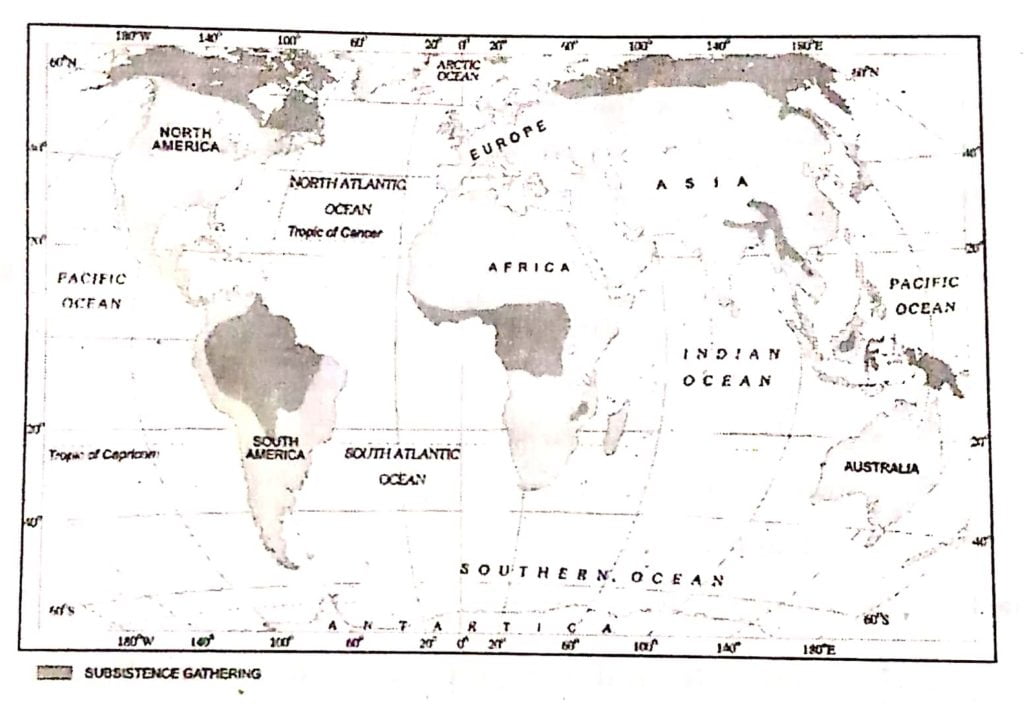Class 12 Geography Chapter 5 Primary Activities The answer to each chapter is provided in the list so that you can easily browse throughout different chapters SCERT Class 12 Geography Chapter 5 Primary Activities and select need one.
Class 12 Geography Chapter 5 Primary Activities
Also, you can read the SCERT book online in these sections Solutions by Expert Teachers as per SCERT (CBSE) Book guidelines. These solutions are part of SCERT All Subject Solutions. Here we have given Assam Board/NCERT Class 12 Geography Chapter 5 Primary Activities Solutions for All Subject, You can practice these here…
LONG TYPE QUESTION & ANSWERS (MARKS-5) 100 WORDS
Q.1. Differentiate between Nomadic Herding and Commercial Livestock Rearing.
Ans :- Nomadic Herding :
(i) Nomadic Herding or pastoral nomadism is a primitive subsistence activity in which the herders rely on animals for food, clothing shelter. tools and transport
(ii) They move from one place to another alongwith their livestock depending on the amount and quality of pastures and water.
(iii) Each nomadic community occupies a well identified territory as a matter of tradition.
(iv) A wide variety of animals is kept in different regions such as Cattle – in tropical Africa Sheep, Goat, Camel – in Sahara and Asiatic deserts. Yak and llamas – Tibet and Andes Reindeer – Arctic and subArctic areas
(v) Animal products are used for domestic purposes.
(vi) They made seasonal movement or migration.
Commercial Livestock Rearing :
(i) Unlike nomadic herding commercial livestock rearing is more organised and capital intensive. It is essentially associated with western cultures and is practised on permanent ranches.
(ii) When the grass of one parcel is grazed, animals are moved to another parcel.
(iii) The ranches cover large areas and are divided into a number of parcels which are fenced to regulate the grazing.
(iv) Commercial livestock rearing is a specialised activity in which only one type of animal is reared. Important animals include sheep, cattle, goats and horses.
(v) Animais products are used for commercial purposes.
(vi) They don’t make seasonal movement or migration.
Q.2. Give the main features of the Intensive subsistence Agriculture
Ans :- The main features of the Intensive subsistence agriculture are :
(i) Intensive subsistence agriculture is largely found in the monsoonal region of Asia where the population is dense.
(ii) Intensive subsistence agriculture is mainly two types – intensive subsistence agriculture dominated by wet paddy cultivation and intensive subsistence agriculture dominated by other crops.
(iii) Land holdings are very small, use of machinery is limited and most of the agricultural operations are done by manual labour in this type of cultivation. The per productivity is law, though the yield per unit area is high Because the population density of these regions are very high.
(iv) Rice is the main crop dominated by wet paddy cultivation. But in some areas wheat, soyabean, barley and sorghum are ground.
Q.3. Distinguish between shifting cultivation and sedentary Cultivation.
Ans :- Distinction between shifting cultivation and sedentary Cultivation are :
(i) Shifting cultivation is when the farmers move one place to another after 2-3 years. It is a temporary practice of cultivation. But the sedentary cultivation is when a farm is based in the same location all the time. So it is called permanent cultivation also.
(ii) In sedentary cultivation the farmer ploughs the land systematically with the help of machines and animals. But in shifting cultivation the farmers use sharp and pointed wooden or iron sticks to dye hale and seeds are planted.
(iii) In shifting types of agriculture, there is no private ownership of land. Land belongs to a community, a village or a tribe. But sedentary farmers are owners of their land.
(iv) The production is law because of infertile soil due to beading, poor seeds, absence of manures, old and outdated implements. The production is consumed locally by the village leaving no surface at all.
The production is comparatively very high than shifting cultivation of sedentary cultivation. Sedentary agriculture is practiced for livelihood as well as commercial purpose. The farmers sell the surplus.
Q.4. Discuss the main features of Mixed Farming.
Ans :- The main feature of mined farming are :
(i) Cereals, root crops, hay and meat animals form the basis of the economy of mixed farming.
(ii) It is characterized by high capital expenditure, on form, machinery and building intensive use of chemical fertilizers and green manners and also by the skill and expertise of the farmers.
(iii) Due to crop rotation, seed selection and application of heavy fertilizers, the yields are high.
(iv) This type of farming is found in the highly developed parts of the world, eg. North-western Europe, Eastern North America Parts of Eurasia and temperate latitudes of Southern continents.
LONG TYPE QUESTION & ANSWERS (MARKS-5)
Q.1. Discuss the salient features of primary, secondary and tertiary activities of humans with suitable examples.
Ans :- Primary activities : Primary activities are those activities which are directly dependent on nature or the environment.
Primary activities include such as hunting of animals, gathering of plant products such as fruits and nuts, fishing, harvesting of crops and trees. Due to the outdoor nature of their work, the people engaged in these activities are often called red-collar workers.
Secondary activities : Secondary activities add value to natural resources by transforming raw materials into valuable products. These activities include processing and increasing the utility of the products of the primary activities for example, cotton in the ball has limited use, but after it is transformed into yarn. Becomes more valuable and can be used for making clothes. So production of textiles by processing fibers abstain from animals or plants and production of steel goods by processing iron ore included in secondary activities workers engaged in the activities of secondary production are often called blue collar workers.
Tertiary activities : Tertiary activities are related to the service sector. These activities are concerned with providing services rather than production of tangible goods. All types of services are special skills preceded exchange of payment, Health, education, law governed and recreation, etc. requires provisional skills. It also requires other theoretical and practical knowledge. These activities include a range of personal and business services and they involve a rapidly growing number of workers in highly developed and diversified areas. Topiary activities involve the commercial output of services rather than the production of tangible goods. People engaged in tertiary activities are called pink collar workers.
Q.2. What do you mean by transhumance? State characteristics of pastoral nomadism.
Ans :- In nomadic herding the herders move from one place to another in search of the food of their livestock their movement in search of partures is undertaken either over vast horizontal distances or vertically from one elevation to another. The process of migration from plain areas to pastures and mountains during summers and again from mountains to plain during winters is known as transhumance.
There are some characteristic of pastoral nomadism are :
(i) Pastoral nomadism is a primitive subsistence activity. The herders rely on animals for food, clothing, shelter, tools and transport,
(ii) Pastoral nomadism is associated with three important regions. The core region extends from the Atlantic shores of North Africa eastwards across the Arabian peninsula into Mongolia and Central china. The second region extends over the tundra region of Eurasia. In the loathem hemisphere there are small areas in South-west Africa and on the island of Manages car.
(iii) Pastoral nomadism follows transhumance. That means the herders migrate from plain to pastures on mountain during summers and again from mountain pastures to plain areas during winters in search of pastures for livestock.
(iv) Nowadays due to imposition of political boundaries and new settlement plains by different countries, the number of pastor nomads has been decreasing.
Q.3. What are the important distinguishing features of shifting cultivation and sedentary cultivation?
Ans :- The major features of cooperative farming are :
(i) A group of farmers form a co-operative society by pooling in their resources voluntarily for a more efficient and profitable farming system. This is called co-operative farming.
(ii) Co-operative society help farmers in all aspects to procure all important inputs of farming
(iii) The society helps farmers to sell the finished product at the most favourable terms and help in processing of quality products at cheaper rates.
(iv) This type of farming is famous in western countries like Denmark. Netherland, Belgium, Sweden etc.
Q.4. Describe the regions of hunting and gathering in the world.
Ans :- Hunting and gathering is a primitive activity. In ancient times people were hunting animals and gathered them to eat. But now it gradually decreased due to various reasons. Yet, in some areas this type of activity is practiced.
The main regions of hunting and gathering are :
(a) High latitude zone which includes northern Canada, northern Eurasia such and southern Chile.
(b) Low latitude zones such as the Amazon Basin, tropical Africa, Northern fringe of Australia and the interior parts of SouthEast Asia.


Hi, I’m Dev Kirtonia, Founder & CEO of Dev Library. A website that provides all SCERT, NCERT 3 to 12, and BA, B.com, B.Sc, and Computer Science with Post Graduate Notes & Suggestions, Novel, eBooks, Biography, Quotes, Study Materials, and more.


